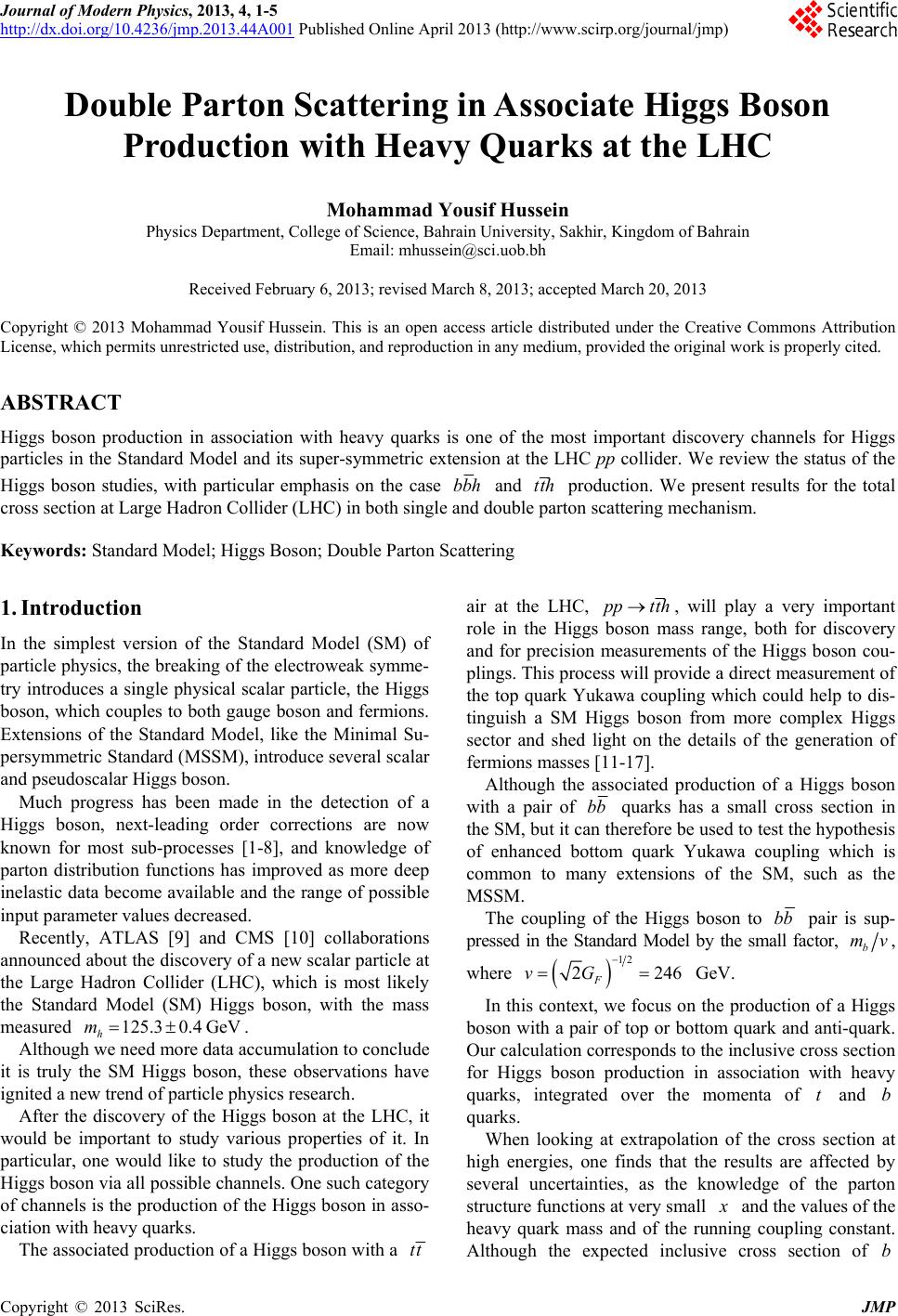 Journal of Modern Physics, 2013, 4, 1-5 http://dx.doi.org/10.4236/jmp.2013.44A001 Published Online April 2013 (http://www.scirp.org/journal/jmp) Double Parton Scattering in Associate Higgs Boson Production with Heavy Quarks at the LHC Mohammad Yousif Hussein Physics Department, College of Science, Bahrain University, Sakhir, Kingdom of Bahrain Email: mhussein@sci.uob.bh Received February 6, 2013; revised March 8, 2013; accepted March 20, 2013 Copyright © 2013 Mohammad Yousif Hussein. This is an open access article distributed under the Creative Commons Attribution License, which permits unrestricted use, distribution, and reproduction in any medium, provided the original work is properly cited. ABSTRACT Higgs boson production in association with heavy quarks is one of the most important discovery channels for Higgs particles in the Standard Model and its super-symmetric extension at the LHC pp collider. We review the status of the Higgs boson studies, with particular emphasis on the case bbh and tt production. We present results for the total cross section at Large Hadron Collider (LHC) in both single and double parton scattering mechanism. h 5.30.4 GeV Keywords: Standard Model; Higgs Boson; Double Parton Scattering 1. Introduction In the simplest version of the Standard Model (SM) of particle physics, the breaking of the electroweak symme- try introduces a single physical scalar particle, the Higgs boson, which couples to both gauge boson and fermions. Extensions of the Standard Model, like the Minimal Su- persymmetric Standard (MSSM), introduce several scalar and pseudoscalar Higgs boson. Much progress has been made in the detection of a Higgs boson, next-leading order corrections are now known for most sub-processes [1-8], and knowledge of parton distribution functions has improved as more deep inelastic data become available and the range of possible input parameter values decreased. Recently, ATLAS [9] and CMS [10] collaborations announced about the discovery of a new scalar particle at the Large Hadron Collider (LHC), which is most likely the Standard Model (SM) Higgs boson, with the mass measured . 12 h m Although we need more data accumulation to conclude it is truly the SM Higgs boson, these observations have ignited a new trend of particle physics research. After the discovery of the Higgs boson at the LHC, it would be important to study various properties of it. In particular, one would like to study the production of the Higgs boson via all possible channels. One such category of channels is the production of the Higgs boson in asso- ciation with heavy quarks. The associated production of a Higgs boson with a tt air at the LHC, pptth, will play a very important role in the Higgs boson mass range, both for discovery and for precision measurements of the Higgs boson cou- plings. This process will provide a direct measurement of the top quark Yukawa coupling which could help to dis- tinguish a SM Higgs boson from more complex Higgs sector and shed light on the details of the generation of fermions masses [11-17]. Although the associated production of a Higgs boson with a pair of bb quarks has a small cross section in the SM, but it can therefore be used to test the hypothesis of enhanced bottom quark Yukawa coupling which is common to many extensions of the SM, such as the MSSM. The coupling of the Higgs boson to bb pair is sup- pressed in the Standard Model by the small factor, b mv, where 12 2 246 F vG b GeV. In this context, we focus on the production of a Higgs boson with a pair of top or bottom quark and anti-quark. Our calculation corresponds to the inclusive cross section for Higgs boson production in association with heavy quarks, integrated over the momenta of t and quarks. When looking at extrapolation of the cross section at high energies, one finds that the results are affected by several uncertainties, as the knowledge of the parton structure functions at very small and the values of the heavy quark mass and of the running coupling constant. Although the expected inclusive cross section of b C opyright © 2013 SciRes. JMP 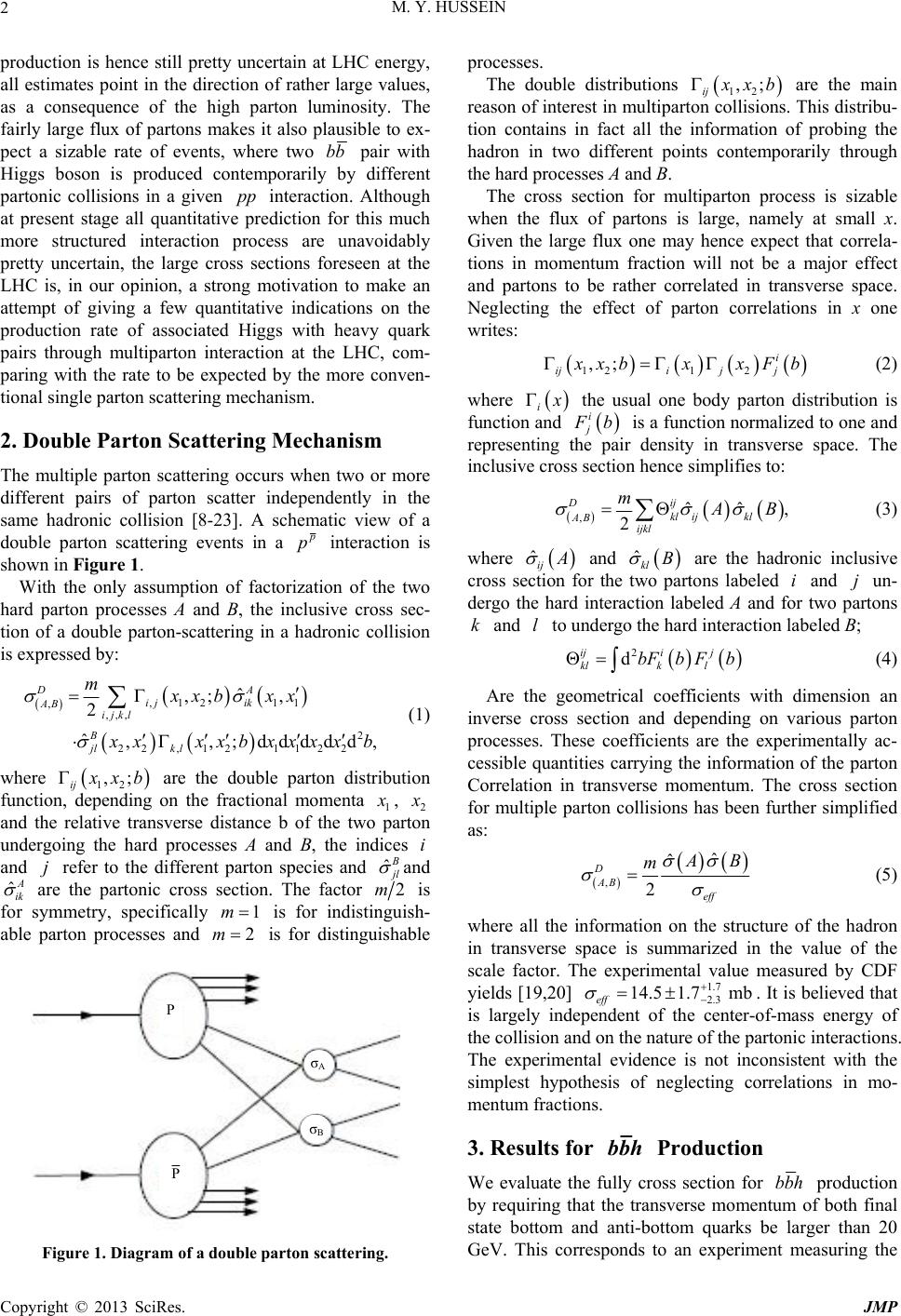 M. Y. HUSSEIN 2 production is hence still pretty uncertain at LHC energy, all estimates point in the direction of rather large values, as a consequence of the high parton luminosity. The fairly large flux of partons makes it also plausible to ex- pect a sizable rate of events, where two bb pair with Higgs boson is produced contemporarily by different partonic collisions in a given interaction. Although at present stage all quantitative prediction for this much more structured interaction process are unavoidably pretty uncertain, the large cross sections foreseen at the LHC is, in our opinion, a strong motivation to make an attempt of giving a few quantitative indications on the production rate of associated Higgs with heavy quark pairs through multiparton interaction at the LHC, com- paring with the rate to be expected by the more conven- tional single parton scattering mechanism. pp 2. Double Parton Scattering Mechanism The multiple parton scattering occurs when two or more different pairs of parton scatter independently in the same hadronic collision [8-23]. A schematic view of a double parton scattering events in a p p interaction is shown in Figure 1. With the only assumption of factorization of the two hard parton processes A and B, the inclusive cross sec- tion of a double parton-scattering in a hadronic collision is expressed by: 2 12 ˆ , ; DA i b ,1 11 , ,, 2 , 1122 ,; , 2 ˆddddd, k AB ij B jlk l mxx xx , 22 , ij kl x ,; xxxxxb xb (1) where 12ij xb are the double parton distribution function, depending on the fractional momenta 1 , 2 and the relative transverse distance b of the two parton undergoing the hard processes A and B, the indices and refer to the different parton species and i ˆ j l and ˆA ik are the partonic cross section. The factor 2m 1 is for symmetry, specifically is for indistinguish- able parton processes and m 2 m is for distinguishable P P σ A σ B ,; Figure 1. Diagram of a double parton scattering. processes. The double distributions 12ij xb are the main reason of interest in multiparton collisions. This distribu- tion contains in fact all the information of probing the hadron in two different points contemporarily through the hard processes A and B. The cross section for multiparton process is sizable when the flux of partons is large, namely at small x. Given the large flux one may hence expect that correla- tions in momentum fraction will not be a major effect and partons to be rather correlated in transverse space. Neglecting the effect of parton correlations in x one writes: 121 2 ,; i iji jj xbxxF b (2) i where the usual one body parton distribution is function and i j b is a function normalized to one and representing the pair density in transverse space. The inclusive cross section hence simplifies to: ,ˆˆ, 2 Dij kl ijkl AB ijkl m B (3) ˆij where and ˆB ij k kl are the hadronic inclusive cross section for the two partons labeled and un- dergo the hard interaction labeled A and for two partons and l to undergo the hard interaction labeled B; 2 d iji j klk l bFb Fb (4) Are the geometrical coefficients with dimension an inverse cross section and depending on various parton processes. These coefficients are the experimentally ac- cessible quantities carrying the information of the parton Correlation in transverse momentum. The cross section for multiple parton collisions has been further simplified as: , ˆˆ 2 D AB eff B m 1.7 14.51.7 mb (5) where all the information on the structure of the hadron in transverse space is summarized in the value of the scale factor. The experimental value measured by CDF yields [19,20] 2.3eff . It is believed that is largely independent of the center-of-mass energy of the collision and on the nature of the partonic interactions. The experimental evidence is not inconsistent with the simplest hypothesis of neglecting correlations in mo- mentum fractions. 3. Results for bbh Production We evaluate the fully cross section for bbh production by requiring that the transverse momentum of both final state bottom and anti-bottom quarks be larger than 20 GeV. This corresponds to an experiment measuring the Copyright © 2013 SciRes. JMP 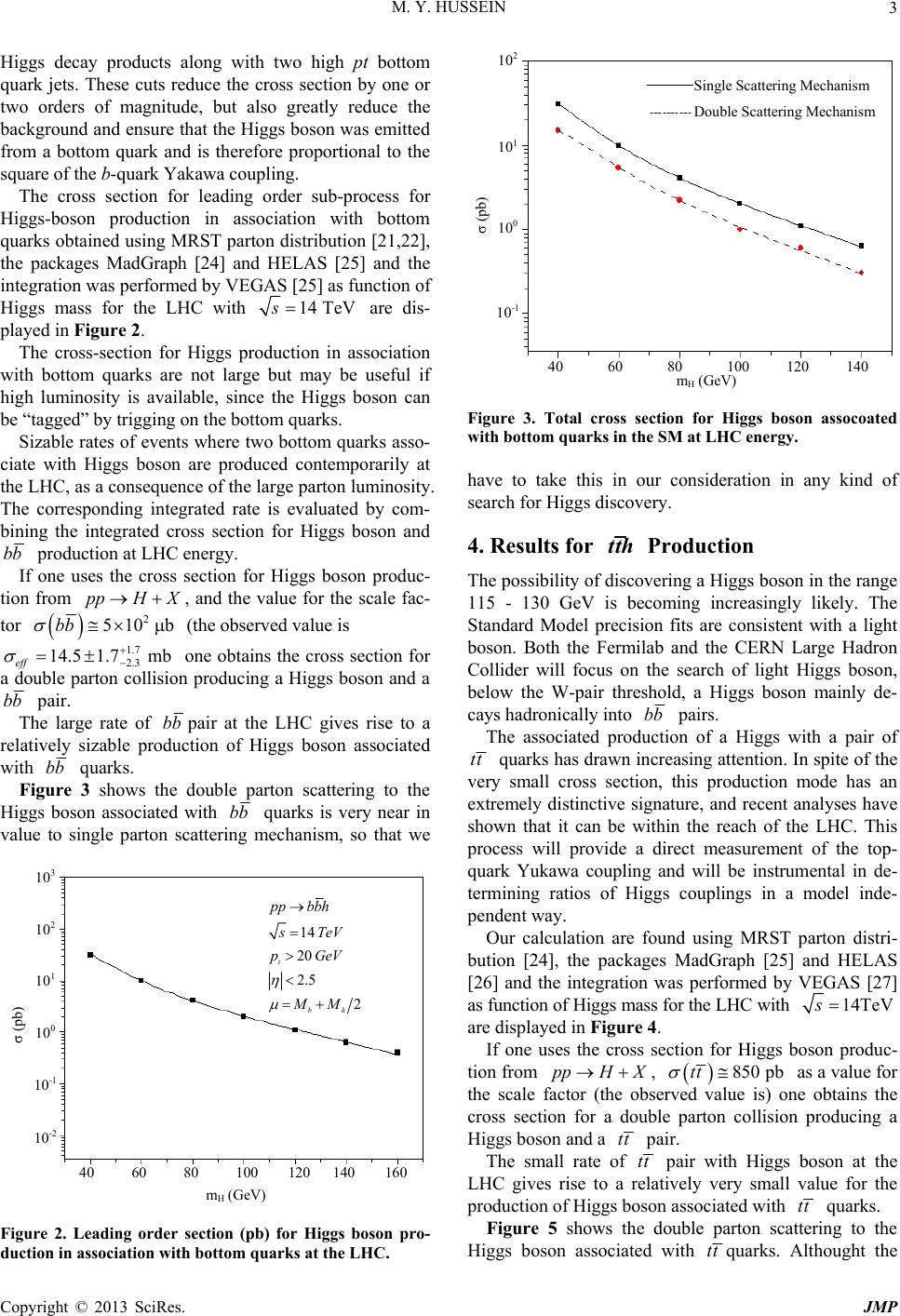 M. Y. HUSSEIN 3 Higgs decay products along with two high pt bottom quark jets. These cuts reduce the cross section by one or two orders of magnitude, but also greatly reduce the background and ensure that the Higgs boson was emitted from a bottom quark and is therefore proportional to the square of the b-quark Yakawa coupling. 10 2 10 1 10 0 10 -1 Single Scattering Mechanism Double Scattering Mechanism The cross section for leading order sub-process for Higgs-boson production in association with bottom quarks obtained using MRST parton distribution [21,22], the packages MadGraph [24] and HELAS [25] and the integration was performed by VEGAS [25] as function of Higgs mass for the LHC with σ (pb) 14 TeVs are dis- played in Figure 2. The cross-section for Higgs production in association with bottom quarks are not large but may be useful if high luminosity is available, since the Higgs boson can be “tagged” by trigging on the bottom quarks. 40 60 80 100 120 140 m H (GeV) Sizable rates of events where two bottom quarks asso- ciate with Higgs boson are produced contemporarily at the LHC, as a consequence of the large parton luminosity. The corresponding integrated rate is evaluated by com- bining the integrated cross section for Higgs boson and bb ppH X production at LHC energy. If one uses the cross section for Higgs boson produc- tion from , and the value for the scale fac- tor 2 510 bbb (the observed value is 1.7 1.7 mb 2.3 one obtains the cross section for a double parton collision producing a Higgs boson and a 14.5 eff bb pair. The large rate of bbpair at the LHC gives rise to a relatively sizable production of Higgs boson associated with bb quarks. Figure 3 shows the double parton scattering to the Higgs boson associated with bb quarks is very near in value to single parton scattering mechanism, so that we 10 3 10 2 10 1 10 0 10 -1 10 -2 14 20 2.5 t pp bbh sT pG 2 bh eV eV MM σ (pb) 40 60 80 100 120 140 160 m H (GeV) Figure 2. Leading order section (pb) for Higgs boson pro- duction in association with bottom quarks at the LHC. Figure 3. Total cross section for Higgs boson assocoated with bottom quarks in the SM at LHC energy. have to take this in our consideration in any kind of search for Higgs discovery. 4. Results for tth Production The possibility of discovering a Higgs boson in the range 115 - 130 GeV is becoming increasingly likely. The Standard Model precision fits are consistent with a light boson. Both the Fermilab and the CERN Large Hadron Collider will focus on the search of light Higgs boson, below the W-pair threshold, a Higgs boson mainly de- cays hadronically into bb pairs. The associated production of a Higgs with a pair of tt quarks has drawn increasing attention. In spite of the very small cross section, this production mode has an extremely distinctive signature, and recent analyses have shown that it can be within the reach of the LHC. This process will provide a direct measurement of the top- quark Yukawa coupling and will be instrumental in de- termining ratios of Higgs couplings in a model inde- pendent way. Our calculation are found using MRST parton distri- bution [24], the packages MadGraph [25] and HELAS [26] and the integration was performed by VEGAS [27] as function of Higgs mass for the LHC with 14TeVs ppH X are displayed in Figure 4. If one uses the cross section for Higgs boson produc- tion from , 850 pbtt as a value for the scale factor (the observed value is) one obtains the cross section for a double parton collision producing a Higgs boson and a tt pair. The small rate of tt pair with Higgs boson at the LHC gives rise to a relatively very small value for the production of Higgs boson associated with tt quarks. Figure 5 shows the double parton scattering to the Higgs boson associated with tt quarks. Althought the Copyright © 2013 SciRes. JMP 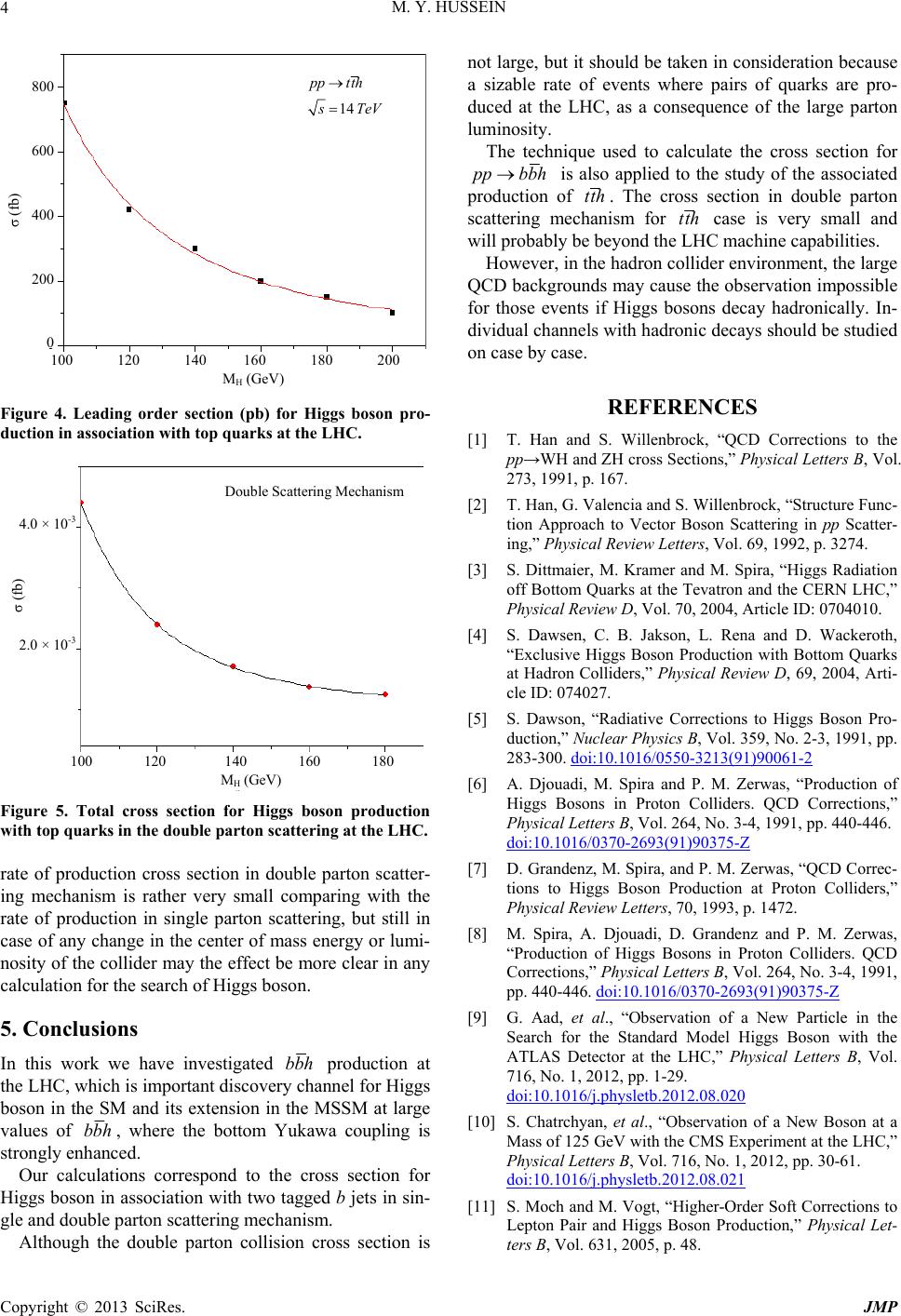 M. Y. HUSSEIN 4 800 600 400 200 14 tthpp TeV σ (fb) 100 120 140 160 180 200 M H (GeV) Figure 4. Leading order section (pb) for Higgs boson pro- duction in association with top quarks at the LHC. 4.0 × 10 -3 2.0 × 10 -3 σ (fb) 100 120 140 160 180 M H (GeV) Double Scattering Mechanism Figure 5. Total cross section for Higgs boson production with top quarks in the double parton scatteri ng at the LHC. rate of production cross section in double parton scatter- ing mechanism is rather very small comparing with the rate of production in single parton scattering, but still in case of any change in the center of mass energy or lumi- nosity of the collider may the effect be more clear in any calculation for the search of Higgs boson. 5. Conclusions In this work we have investigated bb production at the LHC, which is important discovery channel for Higgs boson in the SM and its extension in the MSSM at large values of h bbh , where the bottom Yukawa coupling is strongly enhanced. Our calculations correspond to the cross section for Higgs boson in association with two tagged b jets in sin- gle and double parton scattering mechanism. Although the double parton collision cross section is not large, but it should be taken in consideration because a sizable rate of events where pairs of quarks are pro- duced at the LHC, as a consequence of the large parton luminosity. The technique used to calculate the cross section for pp bbh is also applied to the study of the associated production of tth . The cross section in double parton scattering mechanism for tth case is very small and will probably be beyond the LHC machine capabilities. However, in the hadron collider environment, the large QCD backgrounds may cause the observation impossible for those events if Higgs bosons decay hadronically. In- dividual channels with hadronic decays should be studied on case by case. REFERENCES [1] T. Han and S. Willenbrock, “QCD Corrections to the pp→WH and ZH cross Sections,” Physical Letters B, Vol. 273, 1991, p. 167. [2] T. Han, G. Valencia and S. Willenbrock, “Structure Func- tion Approach to Vector Boson Scattering in pp Scatter- ing,” Physical Review Letters, Vol. 69, 1992, p. 3274. [3] S. Dittmaier, M. Kramer and M. Spira, “Higgs Radiation off Bottom Quarks at the Tevatron and the CERN LHC,” Physical Review D, Vol. 70, 2004, Article ID: 0704010. [4] S. Dawsen, C. B. Jakson, L. Rena and D. Wackeroth, “Exclusive Higgs Boson Production with Bottom Quarks at Hadron Colliders,” Physical Review D, 69, 2004, Arti- cle ID: 074027. [5] S. Dawson, “Radiative Corrections to Higgs Boson Pro- duction,” Nuclear Physics B, Vol. 359, No. 2-3, 1991, pp. 283-300. doi:10.1016/0550-3213(91)90061-2 [6] A. Djouadi, M. Spira and P. M. Zerwas, “Production of Higgs Bosons in Proton Colliders. QCD Corrections,” Physical Letters B, Vol. 264, No. 3-4, 1991, pp. 440-446. doi:10.1016/0370-2693(91)90375-Z [7] D. Grandenz, M. Spira, and P. M. Zerwas, “QCD Correc- tions to Higgs Boson Production at Proton Colliders,” Physical Review Letters, 70, 1993, p. 1472. [8] M. Spira, A. Djouadi, D. Grandenz and P. M. Zerwas, “Production of Higgs Bosons in Proton Colliders. QCD Corrections,” Physical Letters B, Vol. 264, No. 3-4, 1991, pp. 440-446. doi:10.1016/0370-2693(91)90375-Z [9] G. Aad, et al., “Observation of a New Particle in the Search for the Standard Model Higgs Boson with the ATLAS Detector at the LHC,” Physical Letters B, Vol. 716, No. 1, 2012, pp. 1-29. doi:10.1016/j.physletb.2012.08.020 [10] S. Chatrchyan, et al., “Observation of a New Boson at a Mass of 125 GeV with the CMS Experiment at the LHC,” Physical Letters B, Vol. 716, No. 1, 2012, pp. 30-61. doi:10.1016/j.physletb.2012.08.021 [11] S. Moch and M. Vogt, “Higher-Order Soft Corrections to Lepton Pair and Higgs Boson Production,” Physical Let- ters B, Vol. 631, 2005, p. 48. Copyright © 2013 SciRes. JMP 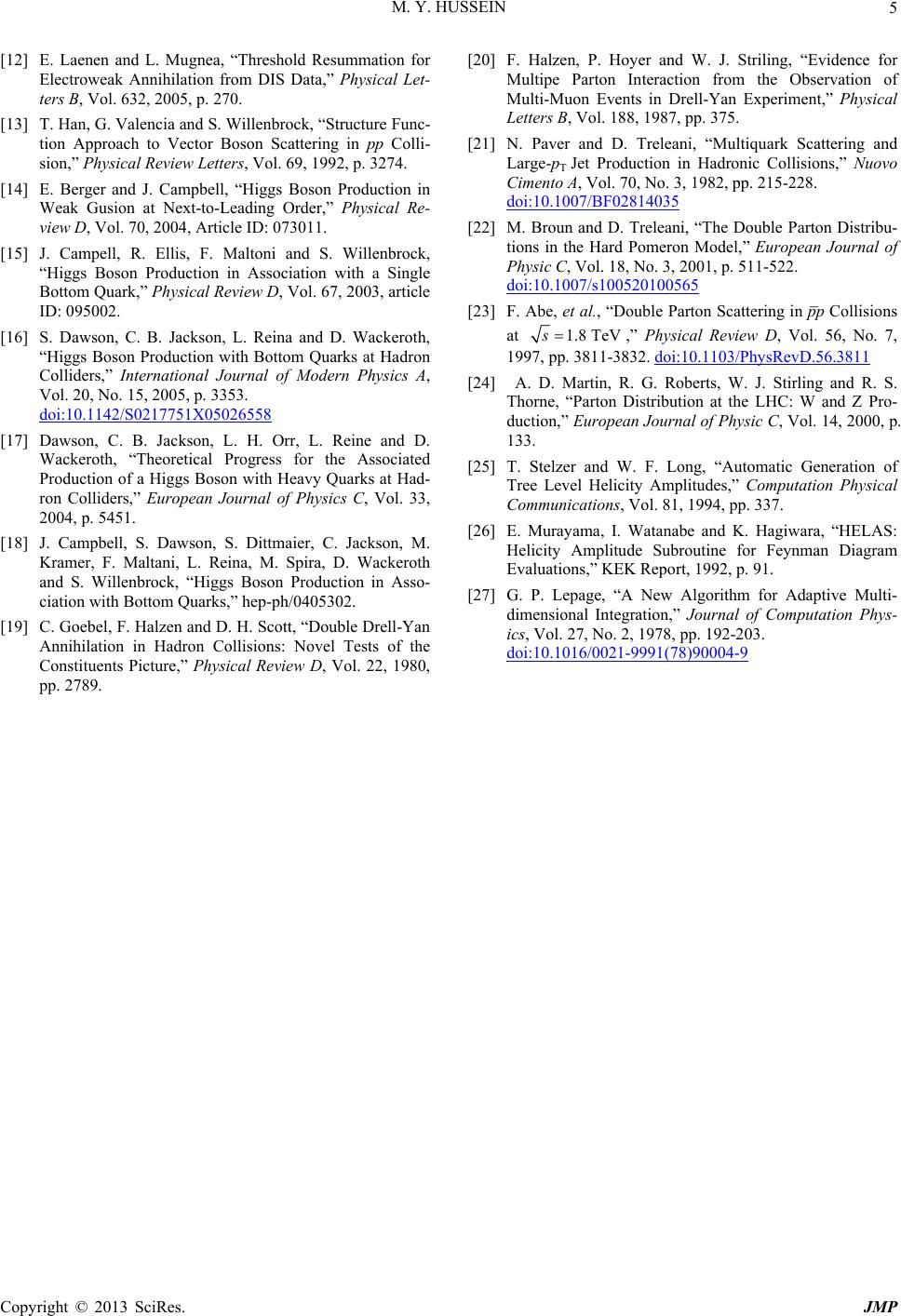 M. Y. HUSSEIN Copyright © 2013 SciRes. JMP 5 [12] E. Laenen and L. Mugnea, “Threshold Resummation for Electroweak Annihilation from DIS Data,” Physical Let- ters B, Vol. 632, 2005, p. 270. [20] F. Halzen, P. Hoyer and W. J. Striling, “Evidence for Multipe Parton Interaction from the Observation of Multi-Muon Events in Drell-Yan Experiment,” Physical Letters B, Vol. 188, 1987, pp. 375. [13] T. Han, G. Valencia and S. Willenbrock, “Structure Func- tion Approach to Vector Boson Scattering in pp Colli- sion,” Physical Review Letters, Vol. 69, 1992, p. 3274. [21] N. Paver and D. Treleani, “Multiquark Scattering and Large-pT Jet Production in Hadronic Collisions,” Nuovo Cimento A, Vol. 70, No. 3, 1982, pp. 215-228. doi:10.1007/BF02814035 [14] E. Berger and J. Campbell, “Higgs Boson Production in Weak Gusion at Next-to-Leading Order,” Physical Re- view D, Vol. 70, 2004, Article ID: 073011. [22] M. Broun and D. Treleani, “The Double Parton Distribu- tions in the Hard Pomeron Model,” European Journal of Physic C, Vol. 18, No. 3, 2001, p. 511-522. doi:10.1007/s100520100565 [15] J. Campell, R. Ellis, F. Maltoni and S. Willenbrock, “Higgs Boson Production in Association with a Single Bottom Quark,” Physical Review D, Vol. 67, 2003, article ID: 095002. [23] F. Abe, et al., “Double Parton Scattering in p ̅p Collisions at 1.8 TeV,” Physical Review D, Vol. 56, No. 7, 1997, pp. 3811-3832. s doi:10.1103/PhysRevD.56.3811 [16] S. Dawson, C. B. Jackson, L. Reina and D. Wackeroth, “Higgs Boson Production with Bottom Quarks at Hadron Colliders,” International Journal of Modern Physics A, Vol. 20, No. 15, 2005, p. 3353. doi:10.1142/S0217751X05026558 [24] A. D. Martin, R. G. Roberts, W. J. Stirling and R. S. Thorne, “Parton Distribution at the LHC: W and Z Pro- duction,” European Journal of Physic C, Vol. 14, 2000, p. 133. [17] D awson, C. B. Jackson, L. H. Orr, L. Reine and D. Wackeroth, “Theoretical Progress for the Associated Production of a Higgs Boson with Heavy Quarks at Had- ron Colliders,” European Journal of Physics C, Vol. 33, 2004, p. 5451. [25] T. Stelzer and W. F. Long, “Automatic Generation of Tree Level Helicity Amplitudes,” Computation Physical Communications, Vol. 81, 1994, pp. 337. [26] E. Murayama, I. Watanabe and K. Hagiwara, “HELAS: Helicity Amplitude Subroutine for Feynman Diagram Evaluations,” KEK Report, 1992, p. 91. [18] J. Campbell, S. Dawson, S. Dittmaier, C. Jackson, M. Kramer, F. Maltani, L. Reina, M. Spira, D. Wackeroth and S. Willenbrock, “Higgs Boson Production in Asso- ciation with Bottom Quarks,” hep-ph/0405302. [27] G. P. Lepage, “A New Algorithm for Adaptive Multi- dimensional Integration,” Journal of Computation Phys- ics, Vol. 27, No. 2, 1978, pp. 192-203. doi:10.1016/0021-9991(78)90004-9 [19] C. Goebel, F. Halzen and D. H. Scott, “Double Drell-Yan Annihilation in Hadron Collisions: Novel Tests of the Constituents Picture,” Physical Review D, Vol. 22, 1980, pp. 2789.
|